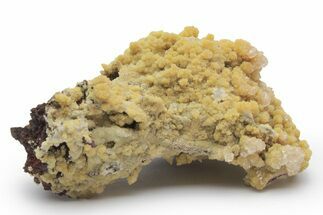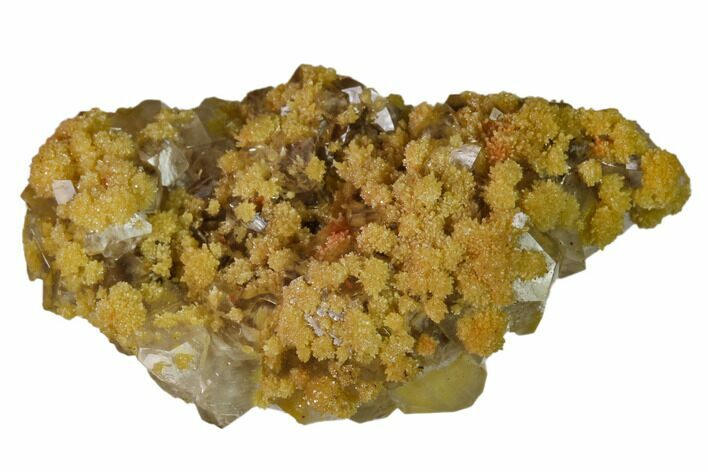This Specimen has been sold.
1.5" Mimetite Crystal Clusters on Calcite - Mexico
This specimen contains yellow-gold mimetite crystal clusters that formed over calcite. This specimen was collected from the Santa Eulalia Mining District in Chihuahua, Mexico.
About Mimetite
Mimetite is a rare lead arsenate chloride mineral, often found in shades ranging from bright yellow to orange, brown, and occasionally green. Its crystals form in a hexagonal structure, typically appearing as prismatic or rounded barrel shapes, though they can also form in botryoidal or globular clusters. This mineral belongs to the apatite group and is closely related to pyromorphite and vanadinite, with which it can sometimes be found in mixed forms. Mimetite's vibrant colors and crystal formations make it a popular specimen among mineral collectors, as it is often highly aesthetic and eye-catching.
This mineral is usually found in the oxidized zones of lead ore deposits, commonly associated with minerals such as galena, wulfenite, and cerussite. It can be found in notable deposits worldwide, including locations in Mexico, Namibia, and Australia, where large and well-formed specimens have been unearthed. Mimetite crystals are relatively fragile due to their lead and arsenic content, requiring careful handling. Despite its appeal, mimetite is not used in jewelry or as a decorative stone because of its toxic elements, making it mainly a collector's mineral.
Mimetite is a rare lead arsenate chloride mineral, often found in shades ranging from bright yellow to orange, brown, and occasionally green. Its crystals form in a hexagonal structure, typically appearing as prismatic or rounded barrel shapes, though they can also form in botryoidal or globular clusters. This mineral belongs to the apatite group and is closely related to pyromorphite and vanadinite, with which it can sometimes be found in mixed forms. Mimetite's vibrant colors and crystal formations make it a popular specimen among mineral collectors, as it is often highly aesthetic and eye-catching.
This mineral is usually found in the oxidized zones of lead ore deposits, commonly associated with minerals such as galena, wulfenite, and cerussite. It can be found in notable deposits worldwide, including locations in Mexico, Namibia, and Australia, where large and well-formed specimens have been unearthed. Mimetite crystals are relatively fragile due to their lead and arsenic content, requiring careful handling. Despite its appeal, mimetite is not used in jewelry or as a decorative stone because of its toxic elements, making it mainly a collector's mineral.
About Calcite Crystals
Calcite crystals are a form of calcium carbonate (CaCO₃) known for their diverse shapes, transparency, and vibrant range of colors. They typically form in rhombohedral, scalenohedral, or prismatic shapes, often with well-defined, sharp edges and glossy surfaces. Calcite crystals are often translucent or transparent, sometimes displaying a double refraction effect where objects viewed through the crystal appear doubled. They can appear in various colors—white, clear, yellow, pink, blue, green, and orange—depending on impurities or trace minerals.
A notable characteristic of calcite is its reaction with weak acids like vinegar, which causes it to effervesce, or fizz, as it releases carbon dioxide. This property makes calcite crystals a key tool in geological identification and studies. Calcite forms in many environments, from sedimentary rocks like limestone and marble to hydrothermal veins.
Calcite crystals are a form of calcium carbonate (CaCO₃) known for their diverse shapes, transparency, and vibrant range of colors. They typically form in rhombohedral, scalenohedral, or prismatic shapes, often with well-defined, sharp edges and glossy surfaces. Calcite crystals are often translucent or transparent, sometimes displaying a double refraction effect where objects viewed through the crystal appear doubled. They can appear in various colors—white, clear, yellow, pink, blue, green, and orange—depending on impurities or trace minerals.
A notable characteristic of calcite is its reaction with weak acids like vinegar, which causes it to effervesce, or fizz, as it releases carbon dioxide. This property makes calcite crystals a key tool in geological identification and studies. Calcite forms in many environments, from sedimentary rocks like limestone and marble to hydrothermal veins.
SPECIES
Mimetite & Calcite
LOCATION
Santa Eulalia, Aquiles Serdán, Chihuahua, Mexico
SIZE
1.5 x .8"
CATEGORY
ITEM
#157079
 Reviews
Reviews












